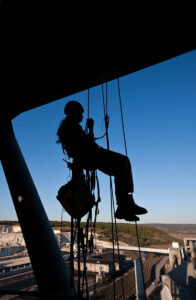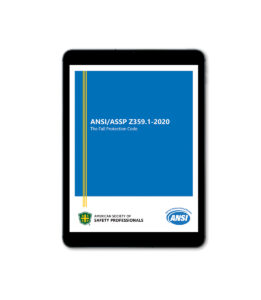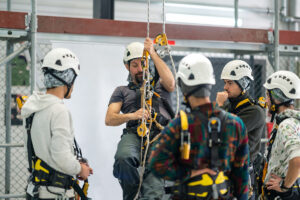Using the Z359 Standards to Improve Your Fall Protection Program

The Z359 standards offer guidance on how to establish an effective fall protection program and properly train end-users.
By Lauren Bauerschmidt and Scott Fowler, Contributors
Working at height exposes workers to a wide range of hazards that can lead to serious injuries and fatalities.
The ANSI/ASSP Z359 fall protection and fall restraint series of voluntary consensus standards provides requirements to help address these hazards and keep workers safe. Lauren Bauerschmidt, MS, CSP, Senior Manager of Standards and Technical Publications for the American Society of Safety Professionals (ASSP), joins us to share insights about the Z359 standards.
What is the history of the Z359 Committee?
The Z359 Committee began in 1992 with the development of the Z359.1 standard. Prior to Z359.1, there were no workplace standards for fall protection equipment or methods. Z359.1, known as the Fall Protection Code, is a set of standards that covers program management, system design, training, qualification and testing, equipment, and component and system specifications for the processes used to protect workers at height in a managed fall protection program. Z359.1 was reaffirmed in 1999. In 2007, it was revised, and four new Z359 standards were developed.
There are currently 15 ANSI/ASSP Z359 fall protection and fall restraint standards, and two additional standards are being written. In 2021, Z359 expanded into rope access work with the approval of the ANSI/ASSP Z459.1 standard, which addresses minimum requirements for system planning and use as well as design, manufacture, and testing of equipment used for rope access.
The Z359 Committee consists of more than 120 individuals from 75 member organizations, including manufacturers, consultants, utility companies, government organizations, and end users. Each organization gets one vote.
What is ASSP’s role in the development of these standards?
ASSP is the secretariat for the Z359 Committee. We ensure that the American National Standards Institute (ANSI) requirements and guidelines — as well as our own requirements for standards development — are followed. We also administer the balloting and voting for standards and oversee the rosters for the main Z359 Committee and all subcommittees. When standards are updated, revised, or reaffirmed, we are responsible for submitting that paperwork to ANSI for approval.
 How does the Z359 Committee choose topics for standards?
How does the Z359 Committee choose topics for standards?
Z359 Committee members work in different areas of the fall protection industry and are aware of the issues facing workers at height. As technology and work environments change, members will come to the committee with issues they are seeing out in the field and propose that there be a standard developed around that topic. The Z359 Committee then votes on whether development of a standard should move forward, and the ASSP Standards Development Committee reviews all standards topics and must provide its approval for a standard to be developed. When a proposed standard is approved, ASSP forms a subcommittee to write the standard.
Why should safety professionals use Z359 standards?
Falls are a leading cause of workplace injuries and fatalities, and fall protection is consistently the most-cited standard in OSHA’s Top 10. Fall protection systems are complex and there are many factors to consider. The Z359 standards will help you develop your fall protection program and understand the different components of a fall protection and fall restraint system. These standards are revised or reaffirmed every five years and reflect current best practices in the industry. The expertise of the members of the Z359 Committee can help give you the information you need to keep your workers as safe as possible.
Which types of construction work and tasks are covered by the Z359 standards?
Fall protection is involved in many different construction activities, including scaffolding, roofing, excavation projects, and bridge work. In the ever-changing environment of construction work, you must be aware of the hazards your workers are facing and provide them the equipment they need to complete their tasks safely. The Z359 standards offer guidance on how to protect workers in these environments.
Which Z359 standards would you recommend to safety professionals involved in construction and demolition safety management?
Fall protection is involved in many different construction activities. The Z359 standards offer guidance on how to establish an effective fall protection program and train end-users on how to properly use different types and components of fall protection equipment.
ANSI/ASSP Z359.2, Minimum Requirements for a Comprehensive Managed Fall Protection Program, establishes criteria and requirements for an employer’s fall protection program, including:
- Policies, duties and responsibilities
- Training
- Survey and identification of fall hazards
- Fall protection procedures
- Eliminating or controlling fall hazards
- Rescue procedures
- Program implementation
- Incident investigation
- Evaluating program effectiveness
ANSI/ASSP Z359.14, Safety Requirements for Self-Retracting Devices for Personal Fall Arrest and Rescue Systems, establishes minimum requirements for self-retracting devices that are used in occupations requiring personal protection against falls from heights and applies to the manufacturers, distributors, purchasers, and authorized persons who use such equipment.
A new Z359.14 User Guidance Bulletin, Self-Retracting Devices for Personal Fall Arrest and Rescue Systems, is now available and designed to be used by safety professionals and end users on their job sites for guidance on the proper use of self-retracting devices.
ANSI/ASSP Z359.15, Safety Requirements for Single Anchor Lifelines and Fall Arresters for Personal Fall Arrest Systems, establishes requirements for the design criteria, qualification testing (performance requirements), marking and instructions, user inspections, maintenance, and storage and removal from service of single anchor lifelines and fall arresters for users within the capacity range of 130 to 310 lbs.
ANSI/ASSP Z359.18, Safety Requirements for Anchorage Connectors for Active Fall Protection Systems, provides verifiable requirements for the design and performance of anchorage connectors, along with test methods to assess conformity to those requirements.
Which Z359 standards would you recommend to someone new to the safety profession or the fall protection industry?

In the ever-changing environment of construction work, you must be aware of the hazards your workers are facing and provide them the equipment they need to complete their tasks safely.
These standards can help familiarize new safety professionals with the elements of an effective fall protection system and different types of fall protection equipment available to help protect workers operating at height.
ANSI/ASSP Z359.0, Z359 Committee Guidance Document for Definitions and Nomenclature Used in Z359 Fall Protection and Fall Restraint Standards, serves as a reference for those in the fall protection industry and defines important terms.
ANSI/ASSP Z359.1, Fall Protection Code, is a set of standards that covers program management, system design, training, qualification and testing, equipment, and component and system specifications for the processes used to protect workers at height in a managed fall protection program.
ANSI/ASSP Z359.2, Minimum Requirements for a Comprehensive Managed Fall Protection Program, establishes the minimum requirements of a fall protection program that will enable an employer to identify, evaluate, eliminate, or control fall hazards in the workplace.
ANSI/ASSP Z359.11, Safety Requirements for Full Body Harnesses, establishes requirements for the performance, design, marking, qualification, instruction, training, test methods, inspection, use, maintenance, and removal from service of full body harnesses.
ANSI/ASSP Z359.18, Safety Requirements for Anchorage Connectors for Active Fall Protection Systems, provides verifiable requirements for the design and performance of anchorage connectors, along with test methods to assess conformity to these requirements.
ANSI/ASSP Z459.1, Safety Requirements for Rope Access Systems, addresses minimum requirements for system planning and use as well as the design, manufacture, and testing of equipment used for rope access.
How does someone join the Z359 Committee and get involved in the standards development process?
You can apply to join the Z359 Committee on the American Society of Safety Professionals website (assp.org) by visiting the site’s Standards Development page and selecting “Volunteer today.” Members start by serving on a subgroup to work on the technical content of a document. From there, you can move to the main committee. Reach out to us and we will be happy to start the process of getting you involved with Z359.
Any closing comments?
Learn as much as you can about the Z359 standards and how they can help you keep workers safe. Reach out to committee members. There are courses and other ways to learn more. It’s OK that you don’t know all the answers, but there are those you can contact who will help you.
Lauren Bauerschmidt, CSP, is Senior Manager of Standards and Technical Publications, American Society of Safety Professionals (assp.org).
Scott Fowler is Content Specialist, American Society of Safety Professionals (assp.org).



